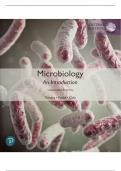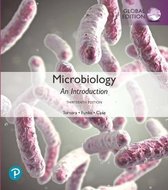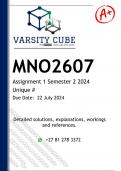, MICROBIOLOGY AN INTRODUCTION 13TH EDITION (GLOBAL
EDITION) BY GERARD TORTORA, BARDELL FUNKE, CHRISTINE
CASE SOLUTIONS MANUAL
CHAPTER
The Microbial World and You
1 Global Edition
Learning Objectives Check Your Understanding
1-1 List several ways in which microbes Describe some of the destructive and beneficial
affect our lives. actions of microbes.
1-2 Define microbiome, normal microbiota, What percentage of all cells in the human body
and transient microbiota. are bacterial cells?
1-3 Recognize the system of scientific Distinguish a genus from a specific epithet.
nomenclature that uses two names: a
genus and a specific epithet.
1-4 Differentiate the major characteristics of Which groups of microbes are prokaryotes?
each group of microorganisms. Which are eukaryotes?
1-5 List the three domains. What are the three domains?
1-6 Explain the importance of observations What is the cell theory?
made by Hooke and van Leeuwenhoek.
1-7 Compare spontaneous generation and What evidence supported spontaneous
biogenesis. generation?
1-8 Identify the contributions to microbiol- How was spontaneous generation disproved?
ogy made by Needham, Spallanzani,
Virchow, and Pasteur.
1-9 Explain how Pasteur’s work influenced Summarize in your own words the germ theory
Lister and Koch. of disease.
1-10 Identify the importance of Koch’s What is the importance of Koch’s postulates?
postulates.
1-11 Identify the importance of Jenner’s What is the significance of Jenner’s discovery?
work.
1-12 Identify the contributions to microbiol- What was Ehrlich’s “magic bullet”?
ogy made by Ehrlich and Fleming.
1-13 Define bacteriology, mycology, parasit- Define bacteriology, mycology, parasitology,
ology, immunology, and virology. immunology, and virology.
, 1-14 Explain the importance of microbial Differentiate microbial genetics, molecular
genetics, molecular biology, and biology, and genomics.
genomics.
1-15 List at least four beneficial activities of Name two beneficial uses of bacteria.
microorganisms.
1-16 Name two examples of biotechnology Differentiate biotechnology from recombinant
that use recombinant DNA technology DNA technology.
and two examples that do not.
1-17 Define resistance. Differentiate normal microbiota and infectious
disease.
1-18 Define biofilm. Why are biofilms important?
1-19 Define emerging infectious disease. What factors contribute to the emergence of an
infectious disease?
New in This Edition
The resurgence in microbiology is highlighted in sections on the Second and Third
Golden Ages of Microbiology.
The Emerging Infectious Diseases section has been updated.
A discussion of normal microbiota and the human microbiome has been added.
Chapter Summary
Microbes in Our Lives (p. 28)
The Microbiome (pp. 28–29)
ASM 5.4: Microorganisms, cellular and viral, can interact with both
human and nonhuman hosts in beneficial, neutral, or detrimental
ways.
ASM 6.2: Microorganisms provide essential models that give us
fundamental knowledge about life processes.
1. Living things too small to be seen with the unaided eye are called microorganisms.
2. Microorganisms are important in maintaining Earth’s ecological balance.
3. Everyone has microorganisms in and on the body; these make up the normal microbiota
or human microbiome. The normal microbiota are needed to maintain good health.
4. Some microorganisms are used to produce foods and chemicals.
5. Some microorganisms cause disease.
Naming and Classifying Microorganisms (pp. 30–32)
ASM 2.4: While microscopic eukaryotes (e.g., fungi, protozoa, and
algae) carry out some of the same processes as bacteria, many of the
cellular properties are fundamentally different.
Nomenclature (p. 30)
, 1. In a nomenclature system designed by Carolus Linnaeus (1735), each living organism is
assigned two names.
2. The two names consist of a genus and a specific epithet, both of which are underlined or
italicized.
Types of Microorganisms (pp. 30–32)
3. Bacteria are unicellular organisms. Because they have no nucleus, the cells are described
as prokaryotic.
4. Most bacteria have a peptidoglycan cell wall; they divide by binary fission, and they may
possess flagella.
5. Bacteria can use a wide range of chemical substances for their nutrition.
6. Archaea consist of prokaryotic cells; they lack peptidoglycan in their cell walls.
7. Archaea include methanogens, extreme halophiles, and extreme thermophiles.
8. Fungi (mushrooms, molds, and yeasts) have eukaryotic cells (cells with a true nucleus).
Most fungi are multicellular.
9. Fungi obtain nutrients by absorbing organic material from their environment.
10. Protozoa are unicellular eukaryotes.
11. Protozoa obtain nourishment by absorption or ingestion through specialized structures.
12. Algae are unicellular or multicellular eukaryotes that obtain nourishment by photosy n-
thesis.
13. Algae produce oxygen and carbohydrates that are used by other organisms.
14. Viruses are noncellular entities that are parasites of cells.
15. Viruses consist of a nucleic acid core (DNA or RNA) surrounded by a protein coat. An
envelope may surround the coat.
16. The principal groups of multicellular animal parasites are flatworms and roundworms,
collectively called helminths.
17. The microscopic stages in the life cycle of helminths are identified by traditional
microbiological procedures.
Classification of Microorganisms (p. 32)
18. All organisms are classified into one of three domains: Bacteria, Archaea, and Eukarya.
Eukarya include protists, fungi, plants, and animals.
A Brief History of Microbiology (pp. 32–40)
ASM 7.4: Ability to understand the relationship between science and
society
The First Observations (pp. 32–33)
1. Hooke’s observations laid the groundwork for development of the cell theory, the
concept that all living things are composed of cells.
2. Anton van Leeuwenhoek, using a simple microscope, was the first to observe
microorganisms (1673).






